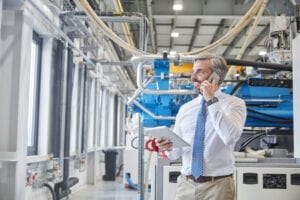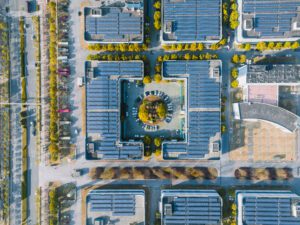In his 1874 book The Mysterious Island, Jules Verne described a world where “water will one day be employed as fuel, that hydrogen and oxygen which constitute it, used singly or together, will furnish an inexhaustible source of heat and light, of an intensity of which coal is not capable.”
149 years later, water is poised to play a crucial role in decarbonizing hard-to-abate sectors. When renewable energy (RE) sources like wind, solar, hydropower splits water into two molecules — H2 and O2 — with no or very low carbon emissions— the result is termed Green hydrogen.
The primary purpose of Green hydrogen is to decarbonize sectors which are hard to electrify. We have technologies and solutions ready in the form of direct electrification and digitization in other applications/sectors (low temperature, light vehicles, etc.). Our focus and energy must be to develop innovative technologies to decarbonize the hard-to-abate processes.
Possible synergy between green hydrogen and artificial intelligence for a sustainable future
Artificial Intelligence (AI) is a critical lever in transforming these challenges into solutions across the different stages of the Green hydrogen project:
- Electrolyzer Giga-Watt factory: Water electrolyzers are at the heart of the Green hydrogen production process. In the net-zero scenario, deployed capacity of electrolysis should increase starting from a few GWs today to nearly 850 GW by 2030, and nearly 3600 GW by 2050. Major challenges include the rapid scaling of electrolyzer manufacturing and incorporation of new innovations within the existing production processes. AI algorithms and data intelligence — together with a software-centric universal automation offer based on the IEC61499 standard for interoperability and portability — optimize the complex production processes by predicting and controlling parameters. This increases efficiency, quality and safety while reducing CapEx and accelerating faster time to market.
- Feasibility studies : Most of the current Green hydrogen projects are in the feasibility study stage. AI enabled power and process simulation gives visibility early in the decision process for investment in Green hydrogen projects, answering
- What power can I get from my wind/solar farm?
- How many electrolyzers do I need?
- What capacity utilization can I expect?
- How does hydrogen production change over time?
- What is the energy demand for hydrogen production?
- How much buffering capacity do I need to plan for?
- What is my carbon footprint?
AI enabled simulation enables optimal sizing and operation strategy and provides visibility to end-to-end economic (LCOH), technical and greenhouse gas emission details at the conception stage, incorporating different vectors like renewable energy models, weather forecasts, electricity market price, electrolyzer models, balance of plants, and hydrogen derivatives.
- Renewable Electricity Generation – AI has a significant role in the design and operation stage of renewable electricity to achieve a better capacity factor. AI can optimize the design of wind turbines and solar panels. By analyzing data on wind patterns or solar irradiance and other environmental factors, AI can determine the optimal placement and design of renewable energy assets, maximizing energy production and reducing the impact of wake effect and other losses.
With the integration of predictive AI analyzing vast amounts of data, we can optimize wind turbine operation in real-time, adjusting blade pitch and other electronic parameters to maximize energy production and reduce wear and tear.
- Digital Twin – Digital twins of the plant connect data from every layer of the technology stack for one contextualized, multi-visual experience from capital project to operations spanning the entire asset lifecycle. AI supercharges the digital twins by providing insights that go beyond what real-world sensors provide. AI enhances digital twins, enabling the technology to look at what-if scenarios and run simulations, predict future values providing previously unavailable insights. Plus, algorithms can quickly pick up on any abnormal information from the sensors. This improved situational awareness of cause and effect supports more agile and sustainable decision-making.
- Energy Management System (EMS) – EMS is the efficient pathway to couple hydrogen production with renewable generation and electric grids with the objective of minimizing energy consumption, reducing system operation costs (OPEX) and maximizing Green hydrogen production of the plant.
An EMS advisor is a cloud-based AI platform that interface with :
- EMS controllers that connect, monitor and control all distributed energy resources (DERs) including photovoltaic (PV), wind, batteries, back-up generators, and grid connectivity of the Green hydrogen plant.
- Unified Power & Process control system that monitor and control the electrolyzer and process and utility requirements of Green hydrogen plant.
AI based Predictive Control algorithms of EMS deploy the Green hydrogen plant’s optimization strategy considering:
- The renewable energy and its forecast.
- Existing Power Purchase Agreements.
- Spot market and its forecast (interface with aggregator).
- Electrolyzer characteristics and lifecycle.
- H2 demand, storage capacity and production forecast.
- Decision to export energy.
- Decision to use the process flexibility.
The role of explainable AI in green hydrogen projects
AI being applied to of Green hydrogen projects handle a lot of complex data to make smart and timely decisions. That said, AI algorithms are ‘black-box’ needing interpretability and explanation so that its decisions can be explained to various stakeholders. These AI algorithms are developed by human developers, trained using imperfect data, and are likely to be biased. Hence, there is a necessity to have ‘Explainable AI’.

Explainable Artificial Intelligence (XAI) will enable users to interrogate the system, receive feedback, understand why it suggested specific courses of action and modify their approach if necessary The integration of AI into the Green hydrogen value chain can optimize the levelized cost of hydrogen (LCOH), thereby significantly contributing to Green hydrogen becoming more competitive with traditional fossil fuels, creating progress toward a more sustainable energy future.
Learn more
Schneider Electric and our strategic partners cover the entire Green hydrogen value chain with proven solutions to address challenges.
To learn more about how Schneider Electric can support your Green hydrogen development efforts, check out our Green hydrogen page under Energies and Chemicals Solutions.



